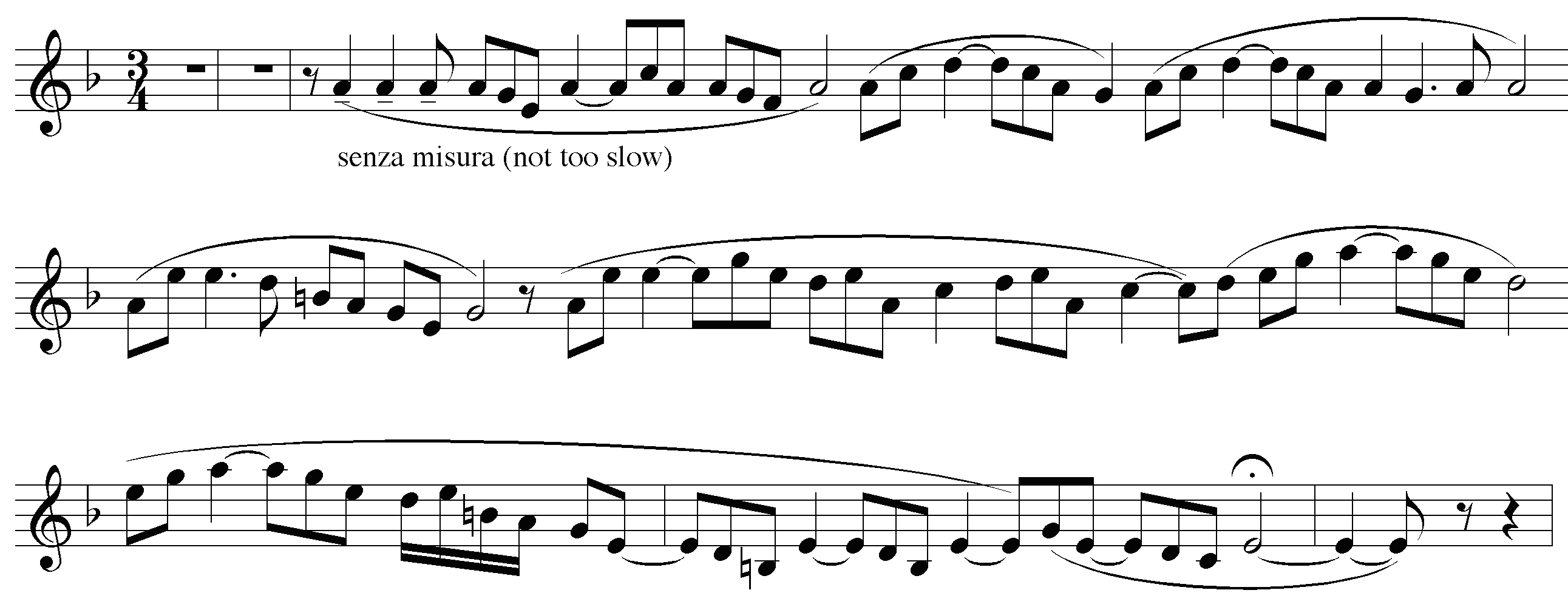Dramatic Vocalise Database
Ralph Vaughan Williams (1872–1958)
Pastoral Symphony [#3] (1921)
In August 1914, at nearly forty-two years of age, Ralph Vaughan Williams was older than the majority of men who fought in the First World War when he volunteered to serve with them in France (despite his age and flat feet), first as a private in the Royal Army Medical Corps, and then in 1918 as a subaltern in the Royal Garrison Artillery.1 In June 1916, his ambulatory unit went to France, its headquarters located at Ecoivres, a village below Mont St. Eloi near Arras. It was during this period that he heard a bugler practicing, giving him the first idea for his Pastoral Symphony.2 The second movement of this symphony, Lento moderato, calls for a natural Eb trumpet. Upon its entry, the score contains the following footnote:
It is important that this passage should be played on a true Eb Trumpet (preferably a natural Trumpet) so that only the natural notes may be played and that the Bb (7th partial) and D (9th partial) should have their true intonation.3
Serious work on the symphony began in 1919, and was completed by the summer of 1921.4 Adrian Boult, conductor of the premiere of Holst’s The Planets, gave the first performance at a Royal Philharmonic Society concert at Queen’s Hall, London, on 26 January 1922. The Pastoral Symphony is a generally optimistic work, one the composer referred to in his first program notes as “almost entirely quiet and contemplative,” 5 yet it is not without moments of underlying passion. One can certainly picture the composer, standing silently alone on a hilltop at dusk, distant sounds drifting across a meadow—a woman’s voice singing a plaintive melody, a bugle call, the hint of an approaching storm, and the stillness that comes with nightfall.
The fourth and final movement returns to the predominant mood of contemplation. It is a slow movement beginning with a traditionally off-stage soprano, although indicated in the score as “Soprano or Tenor Solo. (Distant.),” singing a wordless mostly pentatonic lament over an A pedal-roll in the timpani until the beginning of measure 4.6

Vaughan Williams, Pastoral Symphony, mvt. 4, mm. 1–5
The melody has an overall contour and similar intervallic content, even having an almost identical initial motive as the passage first encountered in the third of the Five Mystical Songs. As the song recedes, the orchestra slowly builds, gradually forming a new, fulsome melody. The music eventually becomes unrestrainedly impassioned when a variant of the vocal melody is heard as a dramatic dialogue between strings and woodwind. Eventually the symphony ends with the distant voice once more, singing a simplified version of the opening material.

Vaughan Williams, Pastoral Symphony, mvt. 4, mm. 156–57
This time the voice is no longer accompanied by a drum roll, but instead, as Donald Tovey calls it, “a high note sustained like the clear sky.” 7 Herbert Howells further explains:
The end itself is a gradual elimination of all complexity of line and color. Only a very soft high A, held by the violins, and under it the voice singing again the greater part of its introductory theme—that is the end of the Symphony.8
Hubert Foss goes so far as to say, “The human voice that heralds and closes the finale is a disembodiment, the spirit of man ecstasized as in a morality or in one of Blake’s drawings.” 9 In the review of the premiere in the Musical Times, Henry Cope Colles wrote:
The theme of the Finale, which is first heard sung by the soprano voice above a distant drum roll and last heard fading away beneath a single violin note, is something more than an incident. It pervades the whole of this wonderful movement, and creates a climax, not a battering climax of full orchestral tone but one reached in an intense unison of violins. This movement is in a sense the finest of the four, or rather it is the one which justifies and fulfils the other three. One has climbed the hill, and can look away to a horizon which seems infinitely distant as the eye is led to it through receding gradations of blue.10
Hugh Ottaway notes the dramatic element of the work, also implying, and elsewhere stating, that the Pastoral is more of a tone poem than a symphony.
For all its indifference to the things commonly held to make a symphony “go,” notably contrasts in tempo, dynamics and basic material, the Pastoral is a dramatic work.11
In another article, Ottaway adds to his description of the Pastoral Symphony:
Whether it be symphonic or not, one recalls this music as a rare testament of beauty; the more so, surely, in that the simple relationship of Man and Nature implicit in the final wordless voice is, in life, so far from the natural sons of the twentieth century.12
Vaughan Williams further explored the relationship between Man and Nature in his later works Riders to the Sea (1936), and the film score to Scott of the Antarctic (1948).
(Nauman 2009, 164–68)
Examples | Comments |